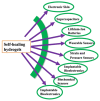Toward Intelligent Materials with the Promise of Self-Healing Hydrogels in Flexible Devices
- PMID: 40006203
- PMCID: PMC11859541
- DOI: 10.3390/polym17040542
Toward Intelligent Materials with the Promise of Self-Healing Hydrogels in Flexible Devices
Abstract
Flexible sensors are revolutionizing wearable and implantable devices, with conductive hydrogels emerging as key materials due to their biomimetic structure, biocompatibility, tunable transparency, and stimuli-responsive electrical properties. However, their fragility and limited durability pose significant challenges for broader applications. Drawing inspiration from the self-healing capabilities of natural organisms like mussels, researchers are embedding self-repair mechanisms into hydrogels to improve their reliability and lifespan. This review highlights recent advances in self-healing (SH) conductive hydrogels, focusing on synthesis methods, healing mechanisms, and strategies to enhance multifunctionality. It also explores their wide-ranging applications, including in vivo signal monitoring, wearable biochemical sensors, supercapacitors, flexible displays, triboelectric nanogenerators, and implantable bioelectronics. While progress has been made, challenges remain in balancing self-healing efficiency, mechanical strength, and sensing performance. This review offers insights into overcoming these obstacles and discusses future research directions for advancing SH hydrogel-based bioelectronics, aiming to pave the way for durable, high-performance devices in next-generation wearable and implantable technologies.
Keywords: flexible electronics; intelligent materials; mechanism; self-healing hydrogels; sensing performance; wearable technologies.
Conflict of interest statement
The authors declare no conflicts of interest.
Figures










References
-
- Rumon M.M.H., Sarkar S.D., Uddin M.M., Alam M.M., Karobi S.N., Ayfar A., Azam M.S., Roy C.K. Graphene oxide based crosslinker for simultaneous enhancement of mechanical toughness and self-healing capability of conventional hydrogels. RSC Adv. 2022;12:7453–7463. doi: 10.1039/D2RA00122E. - DOI - PMC - PubMed
-
- Wang R., Feng Y., Li D., Li K., Yan Y. Towards the sustainable production of biomass-derived materials with smart functionality: A tutorial review. Green Chem. 2024;26:9075–9103. doi: 10.1039/D4GC01771D. - DOI
Publication types
LinkOut - more resources
Full Text Sources

